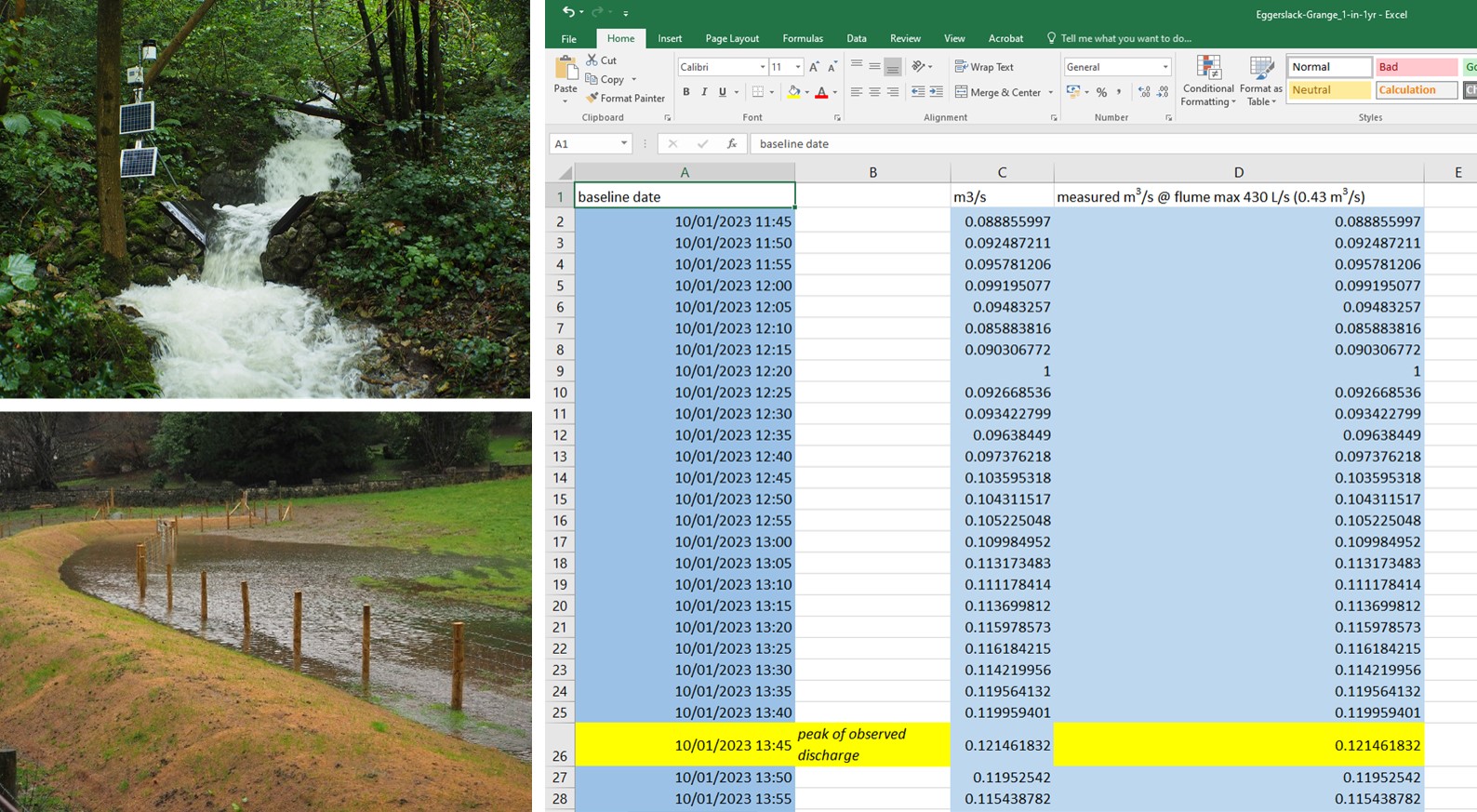eVol-WwNP
Quantifying the benefits of NFM: Equivalnet volume metrics (eVol) as part of the WwNP update
2nd Jan to 30th Aug 2023
This project is being delivered as part of the update to the Environment Agency 'Working with Natural Processes' (WwNP) programme. This programme focuses on the effectivessness of Natural Flood Risk Management (NFM), and involves reviewing research and identifying best management practices for flood mitigation using NFM. Lancaster has a small contribution via the lead for the WwNP review of JBA Consulting.

Example location-specific dataset supporting eVol: Equivalant volume spreadsheet (right) for the effect of the Grange bund (bottom left; shown during a smaller event straight after construction) at the peak of a 1-in-1 year flood, with the upstream flume during a flood event (top left)
The Lancaster eVol-WwNP project has three principal objectives:
- Objective 1 quantify observed flood peak reduction for NFM interventions as equivalent volumes for effective research sites within the NERC Q-NFM project (and NERC Protect project). Derived for observed events with a return period of 1-in-1 year or 1-in-5 year. These data are then used by JBA Consulting to derive changes to floodplain innundation and property damages avoided from NFM. These data are then used by JBA to inform the EA NFM Benefits Tool.
- Objective 2 quantify flood peak reduction for NFM interventions as equivalent volumes for dynatop simulations (based on observed data on local NFM effectiveness) from the NERC Q-NFM project. Derived for events with a return period of 1-in-30 year or 1-in-100 year. These data are then used by JBA Consulting to derive changes to floodplain innundation and property damages avoided from NFM. These data are then used by JBA to inform the EA NFM Benefits Tool.
- Objective 3 comments on drafts of the WwNP review (to JBA Consulting), based on learning from the NERC-funded Q-NFM project and ongoing EA-funded C-NFM project.
Funding sources
Environment Agency (EAA7948) via JBA Consulting
Environment Agency (EAA7953) via JBA Consulting
Investigators
Nick A Chappell (PI), Keith Beven and Field-data Technician David Mindham
Project partner
JBA Consulting (lead for the WwNP review)
Outputs
Pearson, E., Hankin, B., Chappell, N., Beven, K. and Rose, S. 2023. Compilation of new evidence for the effectiveness of measures to emulate natural flood management (NFM) in the last 5 years, EGU General Assembly 2023, Vienna, Austria, 24-28 Apr 2023, EGU23-6368 view online.
The project outputs are primiarily internal MS-Word review documents shared with JBA Consulting, and LU-owned MS-Excel spreadsheets. These outputs are, however, based on the approaches and data presented in public outputs, for example:
Chappell, N.A. and Beven, K. 2024. Nature-based Solutions for effective flood mitigation: potential design criteria. Environmental Research Letters, 19(7): 074006. https://doi.org/10.1088/1748-9326/ad4fa2. view online, or paper (pdf) and Supplementary Information (pdf)
Follett, E., Beven, K., Hankin, B., Mindham, D. and Chappell, N. 2024. The importance of retention times in Natural Flood Management interventions. Proc. IAHS, 385: 197-201. view online, or paper (pdf).
Chappell, N.A., Evans, M., Hammond, J., Hankin, B. Johnston, A. and Adekanmbi, A.A. 2023. Illustrating the value of presenting NERC NFM programme findings as effective volumes at flood peaks, flood damages avoided and learning on soil as an NFM tool. NERC NFM Report Card. Lancaster University, University of Manchester, University of Reading and JBA Consulting. 10.5281/zenodo.10361737. view online.
Beven, K., Page, T., Hankin, B., Smith, P., Kretzschmar, A. Mindham, D. and Chappell, N. 2022. Deciding on fitness-for-purpose - of models and of natural flood management. Hydrological Processes 36: e14752. view online, EIDC access to the data used in this paper.
